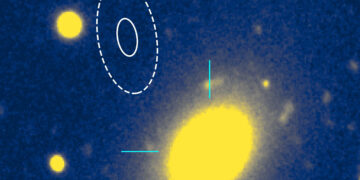Fast radio bursts (FRBs) are among the universe’s most fascinating and perplexing phenomena, but a recent discovery has taken this mystery to new heights. Astronomers detected a repeating FRB, labeled FRB 20240209A, in a location that defies everything we thought we knew.
What Are Fast Radio Bursts, and Why Do They Matter?
Fast radio bursts are incredibly brief yet powerful flashes of radio waves originating from deep space. While most last only milliseconds, their energy rivals the Sun’s total output over an entire day. These bursts are rare cosmic events, and their precise origins have been one of the biggest puzzles in modern astronomy. Until now, theories mostly connected FRBs to magnetars—highly magnetic neutron stars formed from the collapse of massive young stars within star-forming galaxies.
However, FRB 20240209A breaks this mold. Located on the fringes of an 11.3-billion-year-old elliptical galaxy—far removed from regions of active star formation—it challenges long-standing assumptions about the environments that can produce FRBs.
The Discovery of FRB 20240209A
The detection of FRB 20240209A was made possible by the Canadian Hydrogen Intensity Mapping Experiment (CHIME) and its advanced outrigger telescopes. CHIME, known for its sensitivity to fast radio bursts, collaborated with optical telescopes to pinpoint the source of this enigmatic burst. To their astonishment, astronomers traced the burst to a galaxy that has long ceased forming stars.
Further observations revealed that the FRB’s origin is not only in a “dead” galaxy but also situated at its outskirts—a surprising and unexplored environment for such energetic events. Vishwangi Shah, the lead author of the study, noted that the location and nature of FRB 20240209A challenge conventional theories that associate FRBs with young magnetars.
A Galaxy Unlike Any Other
Elliptical galaxies, like the one hosting FRB 20240209A, are typically devoid of the vibrant star formation seen in spiral galaxies like the Milky Way. These galaxies are dominated by old stars and are thought to lack the conditions necessary to produce magnetars. This makes the discovery of an FRB originating from such a galaxy an outlier in astronomical research.
Researchers speculate that the source of this FRB could lie within a globular cluster—a dense collection of ancient stars that orbit the galaxy’s core. If confirmed, it would mark only the second FRB ever associated with a globular cluster.
Advances in Technology Drive Precision
The ability to pinpoint FRBs with such accuracy represents a significant leap forward in astronomical research. CHIME’s addition of outrigger telescopes has vastly improved localization capabilities. Previously, locating an FRB to a specific galaxy was a monumental challenge, but these advancements now allow researchers to associate bursts with precise cosmic neighborhoods.
For FRB 20240209A, this technological breakthrough was key. By combining radio observations with optical telescopes, astronomers could refine the FRB’s position, identify its host galaxy, and explore its surroundings. As Calvin Leung, a lead researcher, explained, these tools provide astrometric precision unmatched by even the Hubble or James Webb Space Telescopes.
Implications for Astrophysics
This discovery has profound implications for our understanding of the universe. It challenges the magnetar hypothesis, suggesting that other mechanisms may be capable of producing FRBs. For example, dense stellar environments like globular clusters may harbor exotic objects or conditions that can trigger these bursts.
Additionally, this FRB raises questions about the life cycles of galaxies and their ability to host extreme astrophysical events. The fact that an ancient galaxy—long past its period of active star formation—can still produce an FRB suggests that the universe may have hidden processes we are only beginning to uncover.
Beyond the Mystery: Using FRBs as Cosmic Tools
Fast radio bursts are not just intriguing mysteries; they also hold the potential to revolutionize how we study the universe. Their short durations and immense energy make them valuable tools for probing the large-scale structure of the cosmos.
FRBs can act as cosmic beacons, allowing astronomers to map the distribution of matter, study intergalactic magnetic fields, and even trace the elusive dark matter that makes up most of the universe’s mass.
The Road Ahead
The discovery of FRB 20240209A is just the beginning. As CHIME continues to refine its capabilities and more outrigger telescopes come online, researchers expect to pinpoint dozens of FRBs every year. This will provide a wealth of data to test theories, identify patterns, and uncover the hidden mechanisms driving these bursts.
Future missions may also leverage these discoveries to explore specific FRB environments in greater detail. For example, targeting globular clusters or elliptical galaxies with next-generation telescopes could provide critical insights into the processes at play.
Why This Discovery Matters
FRB 20240209A is more than just a scientific curiosity—it’s a reminder of how much we still have to learn about the universe. By challenging established theories and opening new avenues of research, this discovery underscores the importance of exploration and technological innovation in advancing human knowledge.
This FRB also highlights the value of collaboration in modern science. From CHIME’s radio arrays to the optical telescopes that confirmed its location, this achievement was only possible through a global effort to push the boundaries of what we can observe and understand.
Conclusion
Fast radio bursts are one of the most exciting frontiers in astronomy, and FRB 20240209A exemplifies why. Located in a surprising and unexplored environment, this discovery challenges our understanding of these enigmatic signals and opens new possibilities for studying the cosmos.
Reference:
Vishwangi Shah et al, A Repeating Fast Radio Burst Source in the Outskirts of a Quiescent Galaxy, The Astrophysical Journal Letters (2025). DOI: 10.3847/2041-8213/ad9ddc
T. Eftekhari et al, The Massive and Quiescent Elliptical Host Galaxy of the Repeating Fast Radio Burst FRB 20240209A, The Astrophysical Journal Letters (2025). DOI: 10.3847/2041-8213/ad9de2



















